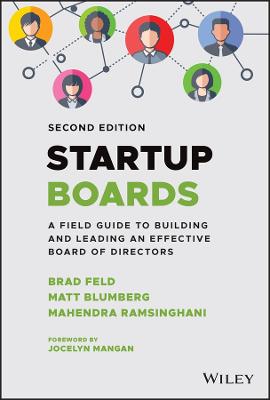Startup Boards
 -15%
portes grátis
-15%
portes grátis
Startup Boards
A Field Guide to Building and Leading an Effective Board of Directors
Feld, Brad; Ramsinghani, Mahendra; Blumberg, Matt
John Wiley & Sons Inc
06/2022
256
Dura
Inglês
9781119859284
15 a 20 dias
526
Descrição não disponível.
Foreword xiii
Prefacex vii
Section 1: Board Fundamentals 1
Chapter 1: Introduction 3
What's New in the Second Edition 4
Who This Book Is For 6
Magic Words, Phrases, Abbreviations, and Style 7
Note 9
Chapter 2 : The Board's Purpose 11
Accountability 12
General Responsibilities 12
Chapter 3: Legal Characteristics 15
A Board Member's Legal Duties 16
Addressing Conflicting Duties 18
Benefit Corporations and the B Corp Movement 20
Should You Get D&O Insurance? 21
Note 23
Chapter 4: Board Member Roles 25
Chair or Lead Director 25
Executive Chair 28
Should You Be Chair of Your Board? 29
Independent Board Members 30
Board Observers 30
Outside Counsel 32
Note 34
Chapter 5: Board Functions 35
The Role of Board Committees 35
Informal Responsibilities of a Board 36
Control Priorities 37
Being Rich and Queen (or King) 39
Shareholder Rights 40
Economic and Performance Priorities 41
Emotional Priorities: Trust, Judgment, and Transparency 42
Notes 43
Section 2: Creating Your Board 45
Chapter 6: Size and Composition 47
Management 48
Investors 49
Independents 50
Matt's Rule of 1s 51
Notes 52
Chapter 7: VCs and Boards 53
Notes 56
Chapter 8: Board Evolution 57
Startup Stages 57
Limiting the Number of Investor Board Members 59
Managing Independent Seats 60
Chapter 9: What to Look for in a Director 63
General Skills 63
Fit with Your Existing Board 64
What Does Your Company Need? 65
Experiences 66
Attributes 69
Governance Philosophy 69
Chapter 10: Recruiting and Interviewing Board Members 71
Sourcing 71
The Interview Process 73
Interviewing VCs Before They Join Your Board 76
Chapter 11: Compensation 77
VCs and Management 77
Independent Directors 78
Notes 80
Chapter 12: Board Diversity 81
Unconscious Bias 81
The First Step: Appoint Independent Directors Early 83
The Second Step: Open Your Search to Board- Ready First- Timers 83
Notes 86
Chapter 13: Onboarding Your Directors 87
Using Employee Onboarding as a Guide 87
Onboarding New Directors 88
Interacting with Your Team 89
Chapter 14: Removing a Board Member 91
Removing a Founder Director 92
Removing an Investor Director 92
Removing an Independent Director 93
Getting Rid of the Entire Board 94
Notes 95
Chapter 15: Is an Advisory Board Useful? 97
Board of Directors vs. Advisory Board 98
Attributes of a Useful Advisory Board Member 99
Selecting Advisory Board Members 100
Building an Advisory Board 100
Challenges of Advisory Boards 101
Notes 102
Section 3: Preparing for and Running the Board Meeting 103
Chapter 16: Preparing for the Board Meeting 105
The Value of Preparation 106
The Meeting Agenda 107
Focus on Critical Items 108
The Board Book 109
Creating an Annual Calendar 113
Notes 114
Chapter 17: Meeting Dynamics 115
Seating 115
The Meeting Length 116
Including Your Team in the Board Meeting 117
Slides or No Slides? 118
Discussion or Decision Item? 118
The Executive Session and the Closed Session 119
A Board Call Instead of a Meeting 120
Remote Attendees and Hybrid Meetings 121
The Post- Meeting Survey 123
Post Meeting 124
Notes 125
Chapter 18: Motions and Votes 127
Robert's Rules of Order 127
Have Your Lawyer at the Meeting 128
The Mechanics of Voting 128
What If You Don't Agree? 129
Dealing with Formal Items 130
Minutes 131
Unanimous Written Consent 131
Notes 132
Section 4: Between Meetings: Ongoing Work 133
Chapter 19: Managing Ongoing Communication 135
What the Board Expects from a CEO 135
Communicate Both Good and Bad News 136
Note 138
Chapter 20: Committees 139
Committee Meeting Formalities 139
Compensation 140
Audit 141
Nominating 142
CEO Expenses 142
Chapter 21: Mentors and Learning by Doing 145
Mentorship and Vulnerability 145
Learning by Doing 147
Chapter 22: CEO Transitions 149
Situations That Lead to a CEO Change 149
Scale Up with Growth 151
Why Boards Fire CEOs 152
Planning for Healthy Transitions 154
Notes 155
Section 5: Transactions 157
Chapter 23: Financings 159
New Investor- Led Round 159
Insider- Led Round 160
The Down Round and a Rights Offering 161
How Involved Should VCs Be in Financings? 161
Convertible Notes 162
Venture Debt 162
Notes 163
Chapter 24: Stock Option Grants and 409A Valuations 165
Chapter 25: Selling a Company 169
Confidentiality 169
Fiduciary Responsibility 170
Your Outside Counsel's Role 171
Acquihire 172
Carve- Outs and 280G 173
Shareholder Representative 173
Note 174
Chapter 26: Buying a Company 175
Negotiating and Structuring the Deal 175
Financing an Acquisition 176
Board Approvals 177
Managing Transaction and Post- Deal Integration 178
Chapter 27: Going Public 179
Process 179
Committees 180
Confidentiality 180
Insider Status 181
VCs on Public Company Boards 181
SPACs 182
Chapter 28: Going Out of Business 185
The Zone of Insolvency 185
Responsibility to Creditors 186
Responsibility to Shareholders 187
Liability 188
Chapter 11 188
Chapter 7 189
Assignment for the Benefit of Creditors 189
Section 6: For Independent Directors and Aspiring Board Members 191
Chapter 29: Preparing for Your First Board Role 193
Note 196
Chapter 30: Interviewing for a Board Role 197
The Interview 197
Diligence Items to Explore 198
Chapter 31: Your First Board Meeting 201
Chapter 32: Communicating Effectively 205
Note 208
Chapter 33: How to Be a Great Board Member 209
Chapter 34: Conclusion 213
Acknowledgments 215
Bibliography 217
Index 221
Prefacex vii
Section 1: Board Fundamentals 1
Chapter 1: Introduction 3
What's New in the Second Edition 4
Who This Book Is For 6
Magic Words, Phrases, Abbreviations, and Style 7
Note 9
Chapter 2 : The Board's Purpose 11
Accountability 12
General Responsibilities 12
Chapter 3: Legal Characteristics 15
A Board Member's Legal Duties 16
Addressing Conflicting Duties 18
Benefit Corporations and the B Corp Movement 20
Should You Get D&O Insurance? 21
Note 23
Chapter 4: Board Member Roles 25
Chair or Lead Director 25
Executive Chair 28
Should You Be Chair of Your Board? 29
Independent Board Members 30
Board Observers 30
Outside Counsel 32
Note 34
Chapter 5: Board Functions 35
The Role of Board Committees 35
Informal Responsibilities of a Board 36
Control Priorities 37
Being Rich and Queen (or King) 39
Shareholder Rights 40
Economic and Performance Priorities 41
Emotional Priorities: Trust, Judgment, and Transparency 42
Notes 43
Section 2: Creating Your Board 45
Chapter 6: Size and Composition 47
Management 48
Investors 49
Independents 50
Matt's Rule of 1s 51
Notes 52
Chapter 7: VCs and Boards 53
Notes 56
Chapter 8: Board Evolution 57
Startup Stages 57
Limiting the Number of Investor Board Members 59
Managing Independent Seats 60
Chapter 9: What to Look for in a Director 63
General Skills 63
Fit with Your Existing Board 64
What Does Your Company Need? 65
Experiences 66
Attributes 69
Governance Philosophy 69
Chapter 10: Recruiting and Interviewing Board Members 71
Sourcing 71
The Interview Process 73
Interviewing VCs Before They Join Your Board 76
Chapter 11: Compensation 77
VCs and Management 77
Independent Directors 78
Notes 80
Chapter 12: Board Diversity 81
Unconscious Bias 81
The First Step: Appoint Independent Directors Early 83
The Second Step: Open Your Search to Board- Ready First- Timers 83
Notes 86
Chapter 13: Onboarding Your Directors 87
Using Employee Onboarding as a Guide 87
Onboarding New Directors 88
Interacting with Your Team 89
Chapter 14: Removing a Board Member 91
Removing a Founder Director 92
Removing an Investor Director 92
Removing an Independent Director 93
Getting Rid of the Entire Board 94
Notes 95
Chapter 15: Is an Advisory Board Useful? 97
Board of Directors vs. Advisory Board 98
Attributes of a Useful Advisory Board Member 99
Selecting Advisory Board Members 100
Building an Advisory Board 100
Challenges of Advisory Boards 101
Notes 102
Section 3: Preparing for and Running the Board Meeting 103
Chapter 16: Preparing for the Board Meeting 105
The Value of Preparation 106
The Meeting Agenda 107
Focus on Critical Items 108
The Board Book 109
Creating an Annual Calendar 113
Notes 114
Chapter 17: Meeting Dynamics 115
Seating 115
The Meeting Length 116
Including Your Team in the Board Meeting 117
Slides or No Slides? 118
Discussion or Decision Item? 118
The Executive Session and the Closed Session 119
A Board Call Instead of a Meeting 120
Remote Attendees and Hybrid Meetings 121
The Post- Meeting Survey 123
Post Meeting 124
Notes 125
Chapter 18: Motions and Votes 127
Robert's Rules of Order 127
Have Your Lawyer at the Meeting 128
The Mechanics of Voting 128
What If You Don't Agree? 129
Dealing with Formal Items 130
Minutes 131
Unanimous Written Consent 131
Notes 132
Section 4: Between Meetings: Ongoing Work 133
Chapter 19: Managing Ongoing Communication 135
What the Board Expects from a CEO 135
Communicate Both Good and Bad News 136
Note 138
Chapter 20: Committees 139
Committee Meeting Formalities 139
Compensation 140
Audit 141
Nominating 142
CEO Expenses 142
Chapter 21: Mentors and Learning by Doing 145
Mentorship and Vulnerability 145
Learning by Doing 147
Chapter 22: CEO Transitions 149
Situations That Lead to a CEO Change 149
Scale Up with Growth 151
Why Boards Fire CEOs 152
Planning for Healthy Transitions 154
Notes 155
Section 5: Transactions 157
Chapter 23: Financings 159
New Investor- Led Round 159
Insider- Led Round 160
The Down Round and a Rights Offering 161
How Involved Should VCs Be in Financings? 161
Convertible Notes 162
Venture Debt 162
Notes 163
Chapter 24: Stock Option Grants and 409A Valuations 165
Chapter 25: Selling a Company 169
Confidentiality 169
Fiduciary Responsibility 170
Your Outside Counsel's Role 171
Acquihire 172
Carve- Outs and 280G 173
Shareholder Representative 173
Note 174
Chapter 26: Buying a Company 175
Negotiating and Structuring the Deal 175
Financing an Acquisition 176
Board Approvals 177
Managing Transaction and Post- Deal Integration 178
Chapter 27: Going Public 179
Process 179
Committees 180
Confidentiality 180
Insider Status 181
VCs on Public Company Boards 181
SPACs 182
Chapter 28: Going Out of Business 185
The Zone of Insolvency 185
Responsibility to Creditors 186
Responsibility to Shareholders 187
Liability 188
Chapter 11 188
Chapter 7 189
Assignment for the Benefit of Creditors 189
Section 6: For Independent Directors and Aspiring Board Members 191
Chapter 29: Preparing for Your First Board Role 193
Note 196
Chapter 30: Interviewing for a Board Role 197
The Interview 197
Diligence Items to Explore 198
Chapter 31: Your First Board Meeting 201
Chapter 32: Communicating Effectively 205
Note 208
Chapter 33: How to Be a Great Board Member 209
Chapter 34: Conclusion 213
Acknowledgments 215
Bibliography 217
Index 221
Este título pertence ao(s) assunto(s) indicados(s). Para ver outros títulos clique no assunto desejado.
Board of directors leadership; board of director governance; corporate governance; board governance; board recruitment; board leadership; building a board of directors; board composition; board evaluation; quantitative board research; startup boards; finding a board role; best practices for board of directors;
Foreword xiii
Prefacex vii
Section 1: Board Fundamentals 1
Chapter 1: Introduction 3
What's New in the Second Edition 4
Who This Book Is For 6
Magic Words, Phrases, Abbreviations, and Style 7
Note 9
Chapter 2 : The Board's Purpose 11
Accountability 12
General Responsibilities 12
Chapter 3: Legal Characteristics 15
A Board Member's Legal Duties 16
Addressing Conflicting Duties 18
Benefit Corporations and the B Corp Movement 20
Should You Get D&O Insurance? 21
Note 23
Chapter 4: Board Member Roles 25
Chair or Lead Director 25
Executive Chair 28
Should You Be Chair of Your Board? 29
Independent Board Members 30
Board Observers 30
Outside Counsel 32
Note 34
Chapter 5: Board Functions 35
The Role of Board Committees 35
Informal Responsibilities of a Board 36
Control Priorities 37
Being Rich and Queen (or King) 39
Shareholder Rights 40
Economic and Performance Priorities 41
Emotional Priorities: Trust, Judgment, and Transparency 42
Notes 43
Section 2: Creating Your Board 45
Chapter 6: Size and Composition 47
Management 48
Investors 49
Independents 50
Matt's Rule of 1s 51
Notes 52
Chapter 7: VCs and Boards 53
Notes 56
Chapter 8: Board Evolution 57
Startup Stages 57
Limiting the Number of Investor Board Members 59
Managing Independent Seats 60
Chapter 9: What to Look for in a Director 63
General Skills 63
Fit with Your Existing Board 64
What Does Your Company Need? 65
Experiences 66
Attributes 69
Governance Philosophy 69
Chapter 10: Recruiting and Interviewing Board Members 71
Sourcing 71
The Interview Process 73
Interviewing VCs Before They Join Your Board 76
Chapter 11: Compensation 77
VCs and Management 77
Independent Directors 78
Notes 80
Chapter 12: Board Diversity 81
Unconscious Bias 81
The First Step: Appoint Independent Directors Early 83
The Second Step: Open Your Search to Board- Ready First- Timers 83
Notes 86
Chapter 13: Onboarding Your Directors 87
Using Employee Onboarding as a Guide 87
Onboarding New Directors 88
Interacting with Your Team 89
Chapter 14: Removing a Board Member 91
Removing a Founder Director 92
Removing an Investor Director 92
Removing an Independent Director 93
Getting Rid of the Entire Board 94
Notes 95
Chapter 15: Is an Advisory Board Useful? 97
Board of Directors vs. Advisory Board 98
Attributes of a Useful Advisory Board Member 99
Selecting Advisory Board Members 100
Building an Advisory Board 100
Challenges of Advisory Boards 101
Notes 102
Section 3: Preparing for and Running the Board Meeting 103
Chapter 16: Preparing for the Board Meeting 105
The Value of Preparation 106
The Meeting Agenda 107
Focus on Critical Items 108
The Board Book 109
Creating an Annual Calendar 113
Notes 114
Chapter 17: Meeting Dynamics 115
Seating 115
The Meeting Length 116
Including Your Team in the Board Meeting 117
Slides or No Slides? 118
Discussion or Decision Item? 118
The Executive Session and the Closed Session 119
A Board Call Instead of a Meeting 120
Remote Attendees and Hybrid Meetings 121
The Post- Meeting Survey 123
Post Meeting 124
Notes 125
Chapter 18: Motions and Votes 127
Robert's Rules of Order 127
Have Your Lawyer at the Meeting 128
The Mechanics of Voting 128
What If You Don't Agree? 129
Dealing with Formal Items 130
Minutes 131
Unanimous Written Consent 131
Notes 132
Section 4: Between Meetings: Ongoing Work 133
Chapter 19: Managing Ongoing Communication 135
What the Board Expects from a CEO 135
Communicate Both Good and Bad News 136
Note 138
Chapter 20: Committees 139
Committee Meeting Formalities 139
Compensation 140
Audit 141
Nominating 142
CEO Expenses 142
Chapter 21: Mentors and Learning by Doing 145
Mentorship and Vulnerability 145
Learning by Doing 147
Chapter 22: CEO Transitions 149
Situations That Lead to a CEO Change 149
Scale Up with Growth 151
Why Boards Fire CEOs 152
Planning for Healthy Transitions 154
Notes 155
Section 5: Transactions 157
Chapter 23: Financings 159
New Investor- Led Round 159
Insider- Led Round 160
The Down Round and a Rights Offering 161
How Involved Should VCs Be in Financings? 161
Convertible Notes 162
Venture Debt 162
Notes 163
Chapter 24: Stock Option Grants and 409A Valuations 165
Chapter 25: Selling a Company 169
Confidentiality 169
Fiduciary Responsibility 170
Your Outside Counsel's Role 171
Acquihire 172
Carve- Outs and 280G 173
Shareholder Representative 173
Note 174
Chapter 26: Buying a Company 175
Negotiating and Structuring the Deal 175
Financing an Acquisition 176
Board Approvals 177
Managing Transaction and Post- Deal Integration 178
Chapter 27: Going Public 179
Process 179
Committees 180
Confidentiality 180
Insider Status 181
VCs on Public Company Boards 181
SPACs 182
Chapter 28: Going Out of Business 185
The Zone of Insolvency 185
Responsibility to Creditors 186
Responsibility to Shareholders 187
Liability 188
Chapter 11 188
Chapter 7 189
Assignment for the Benefit of Creditors 189
Section 6: For Independent Directors and Aspiring Board Members 191
Chapter 29: Preparing for Your First Board Role 193
Note 196
Chapter 30: Interviewing for a Board Role 197
The Interview 197
Diligence Items to Explore 198
Chapter 31: Your First Board Meeting 201
Chapter 32: Communicating Effectively 205
Note 208
Chapter 33: How to Be a Great Board Member 209
Chapter 34: Conclusion 213
Acknowledgments 215
Bibliography 217
Index 221
Prefacex vii
Section 1: Board Fundamentals 1
Chapter 1: Introduction 3
What's New in the Second Edition 4
Who This Book Is For 6
Magic Words, Phrases, Abbreviations, and Style 7
Note 9
Chapter 2 : The Board's Purpose 11
Accountability 12
General Responsibilities 12
Chapter 3: Legal Characteristics 15
A Board Member's Legal Duties 16
Addressing Conflicting Duties 18
Benefit Corporations and the B Corp Movement 20
Should You Get D&O Insurance? 21
Note 23
Chapter 4: Board Member Roles 25
Chair or Lead Director 25
Executive Chair 28
Should You Be Chair of Your Board? 29
Independent Board Members 30
Board Observers 30
Outside Counsel 32
Note 34
Chapter 5: Board Functions 35
The Role of Board Committees 35
Informal Responsibilities of a Board 36
Control Priorities 37
Being Rich and Queen (or King) 39
Shareholder Rights 40
Economic and Performance Priorities 41
Emotional Priorities: Trust, Judgment, and Transparency 42
Notes 43
Section 2: Creating Your Board 45
Chapter 6: Size and Composition 47
Management 48
Investors 49
Independents 50
Matt's Rule of 1s 51
Notes 52
Chapter 7: VCs and Boards 53
Notes 56
Chapter 8: Board Evolution 57
Startup Stages 57
Limiting the Number of Investor Board Members 59
Managing Independent Seats 60
Chapter 9: What to Look for in a Director 63
General Skills 63
Fit with Your Existing Board 64
What Does Your Company Need? 65
Experiences 66
Attributes 69
Governance Philosophy 69
Chapter 10: Recruiting and Interviewing Board Members 71
Sourcing 71
The Interview Process 73
Interviewing VCs Before They Join Your Board 76
Chapter 11: Compensation 77
VCs and Management 77
Independent Directors 78
Notes 80
Chapter 12: Board Diversity 81
Unconscious Bias 81
The First Step: Appoint Independent Directors Early 83
The Second Step: Open Your Search to Board- Ready First- Timers 83
Notes 86
Chapter 13: Onboarding Your Directors 87
Using Employee Onboarding as a Guide 87
Onboarding New Directors 88
Interacting with Your Team 89
Chapter 14: Removing a Board Member 91
Removing a Founder Director 92
Removing an Investor Director 92
Removing an Independent Director 93
Getting Rid of the Entire Board 94
Notes 95
Chapter 15: Is an Advisory Board Useful? 97
Board of Directors vs. Advisory Board 98
Attributes of a Useful Advisory Board Member 99
Selecting Advisory Board Members 100
Building an Advisory Board 100
Challenges of Advisory Boards 101
Notes 102
Section 3: Preparing for and Running the Board Meeting 103
Chapter 16: Preparing for the Board Meeting 105
The Value of Preparation 106
The Meeting Agenda 107
Focus on Critical Items 108
The Board Book 109
Creating an Annual Calendar 113
Notes 114
Chapter 17: Meeting Dynamics 115
Seating 115
The Meeting Length 116
Including Your Team in the Board Meeting 117
Slides or No Slides? 118
Discussion or Decision Item? 118
The Executive Session and the Closed Session 119
A Board Call Instead of a Meeting 120
Remote Attendees and Hybrid Meetings 121
The Post- Meeting Survey 123
Post Meeting 124
Notes 125
Chapter 18: Motions and Votes 127
Robert's Rules of Order 127
Have Your Lawyer at the Meeting 128
The Mechanics of Voting 128
What If You Don't Agree? 129
Dealing with Formal Items 130
Minutes 131
Unanimous Written Consent 131
Notes 132
Section 4: Between Meetings: Ongoing Work 133
Chapter 19: Managing Ongoing Communication 135
What the Board Expects from a CEO 135
Communicate Both Good and Bad News 136
Note 138
Chapter 20: Committees 139
Committee Meeting Formalities 139
Compensation 140
Audit 141
Nominating 142
CEO Expenses 142
Chapter 21: Mentors and Learning by Doing 145
Mentorship and Vulnerability 145
Learning by Doing 147
Chapter 22: CEO Transitions 149
Situations That Lead to a CEO Change 149
Scale Up with Growth 151
Why Boards Fire CEOs 152
Planning for Healthy Transitions 154
Notes 155
Section 5: Transactions 157
Chapter 23: Financings 159
New Investor- Led Round 159
Insider- Led Round 160
The Down Round and a Rights Offering 161
How Involved Should VCs Be in Financings? 161
Convertible Notes 162
Venture Debt 162
Notes 163
Chapter 24: Stock Option Grants and 409A Valuations 165
Chapter 25: Selling a Company 169
Confidentiality 169
Fiduciary Responsibility 170
Your Outside Counsel's Role 171
Acquihire 172
Carve- Outs and 280G 173
Shareholder Representative 173
Note 174
Chapter 26: Buying a Company 175
Negotiating and Structuring the Deal 175
Financing an Acquisition 176
Board Approvals 177
Managing Transaction and Post- Deal Integration 178
Chapter 27: Going Public 179
Process 179
Committees 180
Confidentiality 180
Insider Status 181
VCs on Public Company Boards 181
SPACs 182
Chapter 28: Going Out of Business 185
The Zone of Insolvency 185
Responsibility to Creditors 186
Responsibility to Shareholders 187
Liability 188
Chapter 11 188
Chapter 7 189
Assignment for the Benefit of Creditors 189
Section 6: For Independent Directors and Aspiring Board Members 191
Chapter 29: Preparing for Your First Board Role 193
Note 196
Chapter 30: Interviewing for a Board Role 197
The Interview 197
Diligence Items to Explore 198
Chapter 31: Your First Board Meeting 201
Chapter 32: Communicating Effectively 205
Note 208
Chapter 33: How to Be a Great Board Member 209
Chapter 34: Conclusion 213
Acknowledgments 215
Bibliography 217
Index 221
Este título pertence ao(s) assunto(s) indicados(s). Para ver outros títulos clique no assunto desejado.
Board of directors leadership; board of director governance; corporate governance; board governance; board recruitment; board leadership; building a board of directors; board composition; board evaluation; quantitative board research; startup boards; finding a board role; best practices for board of directors;







